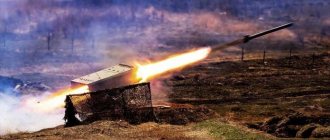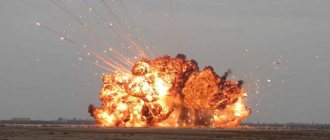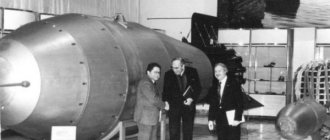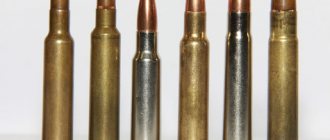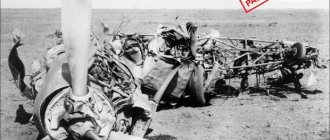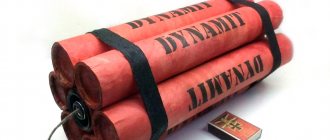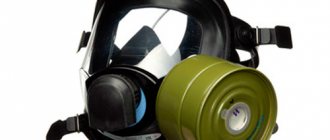Start
The very first explosive substance that humanity became familiar with was gunpowder. It was invented in China at the beginning of our era, but for a long time it was used only as a filler for fireworks and other entertainment shows. And only in the Middle Ages did it become an integral part of almost all wars.
But at the beginning of the 20th century, it was replaced by other explosives, much stronger, safer and more effective. And one of them, which is still used today, is trinitrotoluene or TNT. It is such a widely used and versatile substance that the TNT equivalent has become a measure for high-energy events, for example, explosions of other explosives, the consequences of meteorite impacts and, of course, nuclear bombs. This was done for the convenience of calculations; a kind of universal measuring unit appeared. But first things first.
Parameters of explosive combustion and explosions
- home
- To the engineer
- Explosives
- Parameters of explosive combustion and explosions
1.1. Parameters of explosive combustion and explosions
An explosion is an extremely rapid manifestation of work caused by the expansion of gases or vapors. A substance is called explosive if it has the ability to instantly decompose throughout its entire mass, releasing a significant amount of heat and forming gaseous products. Or in other words, substances capable of chemical reactions accompanied by an explosion are called explosives.
Explosions can be due to physical and chemical causes.
Physical reasons : the creation of large (excessive) pressure inside devices, for example a steam boiler, while the pressure exceeds the strength of the boiler material for which it was designed. In turn, the reasons for the increase in pressure can be a violation of the material balance, an increase in temperature, or the ingress of low-boiling and, consequently, easily evaporating liquids into such an apparatus.
Chemical causes : the occurrence of chemical reactions, as a result of which solid and liquid substances are converted into gases, and a large amount of heat is released. These are the types of explosions that are used in technology.
For example, the explosion of 1 kg of TNT (trinitrotoluene) occurs in one hundred thousandth of a second. In this case, gases are formed, the volume of which under normal conditions (00C) is 700 liters . It is known that when heated by one degree, the volume of a gas increases by 1/273 of its original volume.
The explosion temperature reaches 30,000C, and under these conditions the volume of these gases will be 8,400 liters (12 times more). TNT has a density of 1.6 kg/l, i.e. 1 kg occupies volume: Vtr = 1/1.6 = 0.66 l.
Due to the enormous speed of the reaction and the high speed of its propagation throughout the substance, the resulting gases do not have time to expand noticeably and, at the moment of formation, occupy the volume that the solid substance occupied. In this case, the pressure of the explosion products in this volume should be equal to P = 8400/0.66 = 13000 atm. Since such pressure occurs over a very short period of time, it acts as a sharp blow of enormous force, which causes the destruction or throwing away of objects surrounding the explosive charge. It is generally accepted that explosives are always explosive and should be so. This is a misconception. Explosives (especially those used in technology) are dangerous under certain conditions.
Chemical transformations of explosives can occur in various forms, namely in the form of thermal decomposition, combustion and detonation.
Thermal decomposition is a chemical reaction that occurs throughout the entire volume of a substance, the rate of which is determined by the ambient temperature. Since explosive molecules contain both flammable elements (C, H) and oxygen, the oxidation reaction occurs under any conditions. At normal temperatures, the rate of thermal decomposition for almost all substances used is negligible and all the heat that is generated as a result of the oxidation reaction is spent on heating the environment. If the ambient temperature rises, the reaction rate and the amount of heat generated increases. At a certain temperature, the amount of heat released as a result of a chemical reaction will exceed the amount of heat released into the environment. In this case, self-acceleration of the reaction will begin and a flash (ignition) of the substance may occur.
Explosive combustion is a self-propagating chemical reaction in which the energy of the reacting layers of a substance is transferred to the next layers by heat transfer. In this case, the combustion of explosives occurs similar to the combustion of fuel. When the surface of a TNT charge is heated to approximately 5000C, it will ignite. The chemical reaction proceeds quite quickly, more heat is released than is lost into the environment. As a result of combustion, gases with high temperatures are formed. They heat the next layer of TNT, a chemical reaction begins in it and this is repeated from layer to layer until all the TNT is burned.
Thus, in the case of explosive combustion, as in the case of fuel combustion, layer-by-layer heating occurs by thermal conductivity with the difference that when explosive combustion occurs, there is no need for oxygen supply from the air, because the oxidizing agent is present in the composition of the explosive itself.
Most explosives are organic substances with very low thermal conductivity. It is known that heat transfer by thermal conductivity is a rather slow process, and therefore the combustion rate of explosives is low (about a few millimeters per second). Thus, when burning from the end, a 10 cm high TNT charge burns out in about 15 minutes at atmospheric pressure.
The burning rate depends on external conditions. The burning rate increases if the substance consists of small grains and has many pores. External pressure also has a great influence on the combustion rate. Under certain conditions, with a rapid increase in pressure, explosive combustion can turn into detonation.
Detonation is a self-propagating chemical reaction that is caused by a shock wave moving through an explosive. During detonation, as during combustion, the reaction occurs in a narrow zone moving through the substance, but the mechanism of its propagation is fundamentally different: it is determined by the propagation of the shock wave.
A shock wave is a compression zone moving through a medium at a speed greater than the speed of sound. Behind the compression zone moves a zone of pressure reduction, the so-called rarefaction zone. Shock waves differ from ordinary sound waves in that the pressure, density and temperature at the wave front do not increase continuously, but abruptly, almost instantly. Let us consider the process of propagation of a shock wave along an explosive. If the speed of propagation of a shock wave along an explosive is greater than a certain limit, then, compressing the substance, it heats it or individual sections to a temperature at which an intense chemical reaction begins in the substance. It is due to the energy released during the reaction that the pressure at the shock wave front is maintained constant. For this reason, detonation can propagate over an arbitrarily long path in an explosive charge at a constant speed.
Thus, the detonation speed is the speed of propagation of a shock wave in an explosive, exciting its intense reaction. Detonation always propagates at a speed greater than the speed of sound in the original explosive. The detonation speed for solid and liquid explosives ranges from 1000 to 9000 m/s.
The occurrence of detonation waves can be caused by various reasons: a sharp blow, a rapid increase in pressure during combustion, or the explosion of another explosive.
During detonation, the heated gaseous combustion products at the first moment practically occupy the same volume that the explosive had. Immediately after detonation, the products of an explosion are under enormous pressure (tens and hundreds of thousands of atmospheres), which determines their high speed of expansion and the great destructive effect they have on objects located near the source of the explosion.
In a simplified way, the phenomena occurring during detonation can be represented as follows.
A very strong blow is made to the explosive charge. With such an impact, the upper layer of the charge will compress and become very hot, and a chemical reaction will occur in the compressed layer. Its speed will be much higher than during combustion, since in this case not only high temperature occurs, but also high pressure created by the impact. The resulting gases have nowhere to expand: on one side there is an impact surface, on the other there is a charge, so they will create high pressure, which will compress the adjacent layer of explosives. Compression will cause heating and a rapid chemical reaction. Consequently, during detonation, as well as during combustion, the reaction, having begun on the surface of the charge, will spread deep into it until the entire explosive reacts.
The main difference between detonation and combustion is that the heating that causes the reaction is transmitted not by thermal conductivity, but by a shock wave. Energy transfer by wave occurs much faster than by thermal conduction.
Table: Parameters of the detonation wave of some explosives
| Name BB | Density, g/cm3 | Detonation speed, m/s | Detonation pressure, N/m2 | Medium flow velocity behind the detonation front, m/s | |
| initial | There is detonation in the front. waves | ||||
| TNT (cast) | 1,45 | 1,93 | 6500 | 157/108 | 1625 |
| TNT (presses) | 1,59 | 2,12 | 6900 | 193/108 | 1725 |
| RDX | 1,62 | 2,16 | 8100 | 296/108 | 2025 |
Only those substances whose chemical transformation releases heat can be explosive. The amount of heat released during the explosive decomposition of a substance can also serve as a characteristic of an explosive.
Table: Heat of explosion of some explosives
| Explosive | Heat of explosion QV MJ/kg | QV/QTNT |
| TNT (TNT) | 4,24 | 1 |
| RDX | 5,54 | 1,31 |
| Ten | 5,88 | 1,39 |
| Ammonium picrate | 3,36 | 0,79 |
| Ammotol 50/50 | 4,20 | 0,99 |
| TG 36/64 (TNT/RDX) | 4,80 | 1,39 |
| Smoky gunpowder | 2,79 | 0,66 |
The total work of the explosion is determined by the following factors:
- The greater the ratio of the volume of gases after and before the explosion (final and initial volumes), the greater the work of an explosion.
- The higher the value of the heat of explosion QV, the greater the work of explosion.
- The lower the heat capacity of the explosion products, the greater the work of the explosion.
- Since the heat capacity increases with the number of atoms in the molecule, it is more advantageous to have more diatomic gases (for example, nitrogen N2) in the explosion products; at the same time, the more diatomic gases, the greater the volume of explosion products, which also leads to an increase in the work of the explosion.
- Solids have a high heat capacity. The more solids there are in the explosion products, the greater the total heat capacity of the explosion products and the less the explosion work.
Source: www.studfiles.ru
Age of the Atom
In the early 50s of the last century, the world received a new and monstrously powerful weapon, based on the energy of the decay of uranium atoms, and later plutonium.
To put it simply, the first atomic bombs operated on a fairly simple “cannon” principle. It was then that the need arose for such a method of measuring their explosions as a TNT equivalent. Two pieces of highly enriched uranium were placed in a hollow “tube” opposite each other, and at the right moment, the detonation of a chemical explosive collided them with enormous force, as a result of which a chain reaction of the decay of uranium atoms was started, accompanied by a colossal explosion. For example, the TNT equivalent of the nuclear weapon dropped on Hiroshima ranged from 13 to 18 kilotons. But how is it designated?
TNT (explosives)
High explosive of normal power. Known as:
- Trinitrotoluene.
- Tol.
- Trinit.
- Nitrotol.
- TNT.
Abbreviations:
- TNT.
- TNT.
- T.
Main characteristics:
- Sensitivity:
Insensitive to impact, bullet penetration, fire, spark, friction, chemical exposure. Pressed and powdered TNT is highly sensitive to detonation and explodes reliably from standard detonator caps and fuses. Fused and flaked TNT has a reduced sensitivity to detonation and requires an intermediate detonator in the form of a certain amount of pressed TNT. - The energy of explosive transformation
is 1010 kcal/kg. - Detonation speed:
6900 m/sec. - Brisance:
19 mm. - High explosiveness:
285 cc. - Chemical resistance:
Does not react with solid materials (metal, wood, plastics, concrete, brick, etc.), does not dissolve in water, is not hygroscopic, does not change its explosive properties during prolonged heating, wetting with water, and changes in the state of aggregation (in molten form). Under prolonged exposure to sunlight, it darkens and slightly increases its sensitivity (theoretically). When exposed to an open flame, it ignites and burns with a yellow, highly smoky flame. Combustion in a confined space of a large amount can develop into detonation (theoretically, this does not occur in practice). - Duration and operating conditions:
Duration is not limited (TNT manufactured in the early thirties works reliably). A long (60-70 years) stay in water, soil, or ammunition casings does not change the explosive properties. - Normal state of aggregation:
Solid. Used in powder, flake and solid form - Density:
1.66 g/cu. cm.
Under normal conditions, TNT is a solid substance. It melts at a temperature of +81 degrees, and lights up at a temperature of +310 degrees.
TNT is a product of the action of a mixture of nitric and sulfuric acids on toluene. The output is flaked TNT (individual small flakes). From flaked TNT, mechanical processing can produce powdered, pressed TNT, and fused TNT by heating.
TNT has found the widest application due to the simplicity and convenience of its mechanical processing (it is very easy to make charges of any weight, fill any cavities, cut, drill, etc.), high chemical resistance and inertness, and immunity to external influences. This means it is very reliable and safe to use. At the same time, it has high explosive characteristics.
TNT is used both in pure form and in mixtures with other explosives (RDX, tetryl, PETN, ammonium nitrate explosives, etc.), and TNT does not enter into chemical reactions with them. In a mixture with hexogen, tetryl, PETN, TNT reduces the sensitivity of the latter, and in a mixture with ammonium nitrate explosives, TNT increases their explosive properties, increases chemical resistance and reduces hygroscopicity.
TNT in Russia is the main explosive for filling shells, missiles, mortar mines, aerial bombs, engineering mines and landmines. TNT is used as the main explosive when carrying out blasting operations in the ground, blasting metal, concrete, brick and other structures.
In Russia, TNT is supplied for blasting operations:
- Flaked in kraft paper bags weighing 50 kg.
- In pressed form in wooden boxes (checkers 75, 200, 400 g)
TNT blocks are available in three sizes:
- Large - 10x5x5 cm in size and weighing 400 g. The ignition socket is on the side.
- Small - 10x5x2.5 cm in size and weighing 200 g. Ignition socket on the end face
- Drilling - with a diameter of 3 cm, a length of 7 cm and a weight of 75 g. The ignition socket is at the end.
All checkers are wrapped in waxed paper of red, yellow, gray or gray-green color. On the side there is the inscription “TNT block ... g.”
The location of the ignition socket is marked on paper with a black circle. The ignition socket is the size of a standard detonator cap No. 8. The ignition socket can be smooth or have a 1M10x1N thread in the upper part for a standard MD-5 fuse. In some cases, to increase the strength of the thread, it is covered with foil. There is an inscription on the side of the checker about the presence of threads.
Checkers are placed in wooden boxes in the following configurations:
- 250 drill bits. Box weight 26 kg. Net weight - 18.75 kg.
- 124 small blocks + 1 drill block. Box weight 32 kg. Net - 24.875 kg.
- 62 large checkers + 1 drill checker. Box weight 32 kg. Net -24.675 kg.
- 30 large checkers + 65 small checkers. Box weight 32 kg. Net -25 kg.
Demolition charges of the required mass are made from large and small TNT blocks. A box with TNT blocks can also be used as a demolition charge weighing 25 kg. To do this, there is a hole in the center of the top cover for the fuse, covered with an easily removable board. The checker under this hole is placed so that its ignition socket is located just under the hole in the lid of the box. The boxes are painted green and have wooden or rope handles for carrying. The boxes are marked accordingly.
The diameter of the drill bit corresponds to the diameter of a standard rock drill. These blocks are used to assemble drilling charges when breaking rocks.
TNT is also supplied to the engineering troops in the form of ready-made charges in a metal shell, which has sockets for various types of fuses and fuses, and devices for quickly securing the charge to a destructible object. These are charges SZ-1, SZ-3 (1 and 3 kg of explosives), SZ-3a (3.7 kg of a mixture of TNT with hexogen), SZ-6 (7.3 kg of a mixture of TNT with hexogen), SZ-6m (extended charge weighing 6.9 kg), KZ-2 (shaped charge weighing 9 kg), KZU (extended shaped charge weighing 12 kg) and a number of other charges.
In the figure: 1 - charge SZ-3, 2 - charge SZ-3a, 3 - charge SZ-6m, 4 - shaped charge KZK.
From the author.
TNT is currently the main explosive not only in Russia, but also in most countries. Its popularity is explained simply by its chemical resistance, insensitivity to almost all external influences, safety in production and use, and reliability of operation. TNT melts easily and in this form it is easy to fill any containers or ammunition cavities. Pressed troil is easy to machine (drilling, planing, cutting). The explosive properties of TNT change little during melting, pressing, and grinding. It is chemically passive and can be easily added to any explosive mixture. At the same time, TNT has good explosive characteristics. It is no coincidence that TNT is universally recognized as a standard explosive. Explosion products (residual gases) are not particularly toxic and are more likely to have an irritating effect than anything else.
TNT tastes very bitter, and looks like laundry soap, nothing more than a wooden block. So the stories of idle scribblers about women’s attempts to wash clothes with TNT blocks they found are more like soldier’s anecdotes, taken by journalists at face value.
Veremeev Yu.G.
Magnitude
According to the officially accepted designation, the TNT equivalent is divided into the following quantities:
- Gram.
- Kilogram.
- Tones.
- Kiloton (thousand ton).
- Megaton (million tons).
To put it simply, the equivalent of TNT is how much of a similar substance is needed to repeat a particular explosion or phenomenon - a volcanic eruption, etc.
Hiroshima and Nagasaki
On August 6, 1945, the first and, fortunately, last real use of atomic weapons in military operations took place. The nuclear explosion in Hiroshima was a terrible tragedy for its inhabitants because, like any other weapon of mass destruction, it does not discriminate between civilian and military populations. The explosion almost completely destroyed the city.
Although from a technical point of view, the design of that bomb was far from perfect. As a result, of the entire mass of working uranium, only 1% succumbed to fission. Perhaps it was this factor that allowed us to avoid even greater casualties.
The nuclear explosion in Hiroshima is still, many decades later, the subject of debate about its necessity and general justification, since a horrific number of civilians died, and many more were left maimed for life as a result of a powerful flash of light that set fire to buildings and incinerated people in moments .
And three days later, a similar fate befell the residents of Nagasaki.
There is a misconception that it was these bombings that ended the Second World War by US forces. But that's not true. They only brought closer the imminent end to the exhausted Imperial Japanese Army, which was fighting on two fronts against the United States in the Pacific Ocean and the USSR in the Far East.
The explosion in TNT equivalent of the bomb that fell to Hiroshima ranged from 13 to 18 thousand tons of TNT (kilotons), and Nagasaki - 21 kilotons.
What does the phrase “7 kg of TNT equivalent” mean? How do forensic scientists work at the scene of a terrorist attack?
An hour after the terrorist attack at Moscow's Domodedovo airport, Russian authorities said the power of the explosion was approximately 5 kg of TNT, and a few minutes later - 7 kg. How can you estimate the power of an explosive device so quickly? After a terrorist attack, forensic scientists first examine the damage to assess the power of the explosion. The shape of the shock wave propagation is hemispherical. It is obvious that glass breaks, walls are deformed, and as a result, the roof may partially or completely collapse, doors are squeezed out. People get injured: due to increased pressure, which causes damage to internal organs, eyes, eardrums; due to flashes, which are called “wounding”, due to the collapse of buildings, falling of various objects. An explosion with a power of 7 kg of TNT could damage the eardrums of people within a radius of up to 12 meters, destroy a brick wall within a radius of 14 meters and break glass within a radius of 64 m. Examining all this destruction, experts speak out about the power of the explosion, but this estimate is only approximate. For example, injuries also depend on the position and orientation of the body at the time of the explosion. In addition, the consequences of an explosion of the same device will be different in an open area and in a building. The damage caused by an explosion in a building is more significant because the shock wave is reflected from surfaces. If there are windows, then the wave comes out, but it seems to bounce off the walls. Therefore, the structure of the explosion site is of great importance (the distance estimates presented above are based on calculations in a room similar to an airport). TNT equivalent An estimate of the power of an explosion is given in TNT equivalent, a unit of measurement that allows one to determine the energy released by the explosion. 7 kg of TNT means the destruction is equivalent to what would occur if the explosive device were 100% TNT - like those sometimes used in the military or to demolish a building. They talk about equivalents because this is how all types of explosions are measured, not just those caused by TNT in its pure form. To quickly assess what explosives were used, forensic scientists use special substances that change color when certain explosives are present at the site. But these kits can also give false positives, especially if there are other substances at the explosion site that cause the reagents to react. There are more sophisticated explosives detectors, such as ion mobility mass spectrometers (IMS), which are also used in airport security screening. In all cases, the first estimates must be confirmed by other methods of analysis. The most reliable is the extraction method - experts remove elements from the site of an explosion, from the crater formed by the explosion, or from the bodies of victims or suicide bombers in the event of a suicide attack. Forensic scientists wipe large areas with cotton and solvent, after which what is found is placed in a vacuum and heated to establish the products present. In the case of the January 24 explosion, the type of explosive would likely be easy to determine because there was an abundance of explosives and therefore the chances of finding traces on fragments that were in direct contact with the explosive were high. Detonator The most difficult thing is establishing the architecture of the detonation system. To do this, it is necessary to cordon off the explosion site, because the fragments that need to be detected are extremely small, and at the same time it is also necessary not to interfere with the work of rescuers. Forensic scientists can take the clothes of the wounded before they are taken from the scene of a tragedy, require rescuers to check whether any elements are stuck in the bodies of the wounded, and require pathologists to remove fragments from the bodies of the dead. Correct installation of the detonation system often allows one to reach any terrorist group, because terrorists often use the same detonation method. The last task is to determine the quantity. It does not necessarily correspond to the weight in TNT equivalent. If the explosive is homemade, then its behavior may depend on many parameters: how well the various components are mixed, how tightly the elements fit together, what type of detonator. But an explosive device made in a factory explodes in a previously known way. An explosion of the magnitude that occurred at the Moscow airport certainly required approximately seven liters of explosive material, and this could be carried in a suitcase or even a backpack on the back. Such analytical work makes it possible to determine the methods of action of terrorists and take appropriate security measures. So, after the failed explosion of the “shoe terrorist” Richard Reid (in 2001, this 28-year-old Briton brought an explosive device onto a plane flying from Paris to Miami, which he hid in his shoe. The explosion did not occur: the criminal was neutralized by passengers - editor's note .), who hid a liquid explosive in his boots, the authorities decided to prohibit liquids with a volume of more than 100 ml from being carried on board the plane, because it is believed that using a substance of a smaller volume is impossible to cause destruction on the plane. The author thanks the head of the fire and explosion unit of the Toulouse police forensic laboratory, Dominique Deharo.
Peaceful atom
In addition to nuclear weapons, the “curb” of radioactive substances also gave people an almost inexhaustible source of energy in the form of reactors of various designs, ranging from huge steam turbines that supply entire cities with electricity, to compact radioisotopes, the so-called RTGs, which were widely produced during the USSR and served for power supply for lighthouses, research and Arctic stations. It is noteworthy that they began to dispose of them only in our years and they were not particularly protected. It got to the point that enterprising local residents tried to sell RTGs for scrap metal.
Fortunately, the nuclear war that was so feared during the confrontation between the USSR and the USA did not happen. And nuclear arsenals serve, rather, as a preventive measure, which restrains countries from mutual destruction or starting a new world war.


